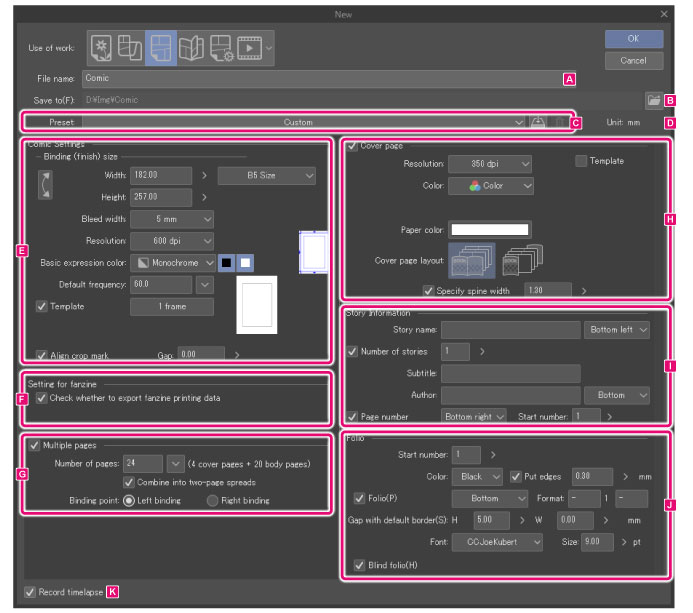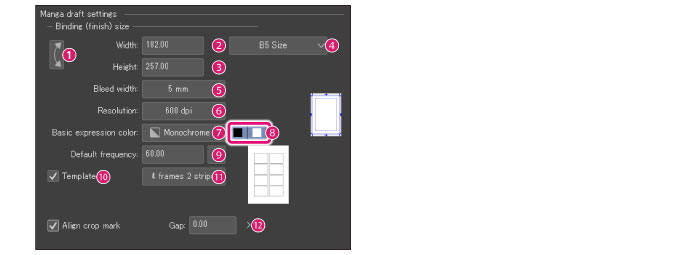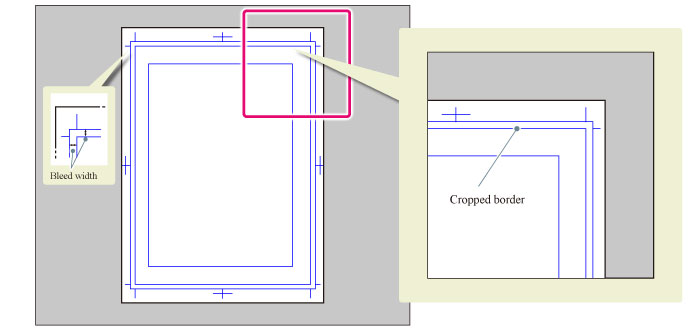New dialog box (Comic) [PRO/EX]
These are the settings that appear when [Comic] is selected as the [Use of work].

|
|
In EX, you can change settings for multiple pages, cover pages, story information, and the folio after creating the file. To learn about these settings, see "Change basic work settings". |
A.File name
Enter a save name for your file.
When creating a work with multiple pages in EX, this will be the name of the page management file (extension: cmc). The entered file name will also be used as the name of the management folder.
B.Save to [EX]
Specifies the location where the management folder will be created. Click [Browse] to specify the location. This option appears when [Multiple pages] is turned on.
|
|
In EX, works made of multiple pages are stored inside a management folder as the management file and separate Clip Studio format files for each page. For details, see "Regarding Management File and Page Files". |
C.Preset

(1) Preset
Selects the finish size and resolution from a list of options.
|
|
If you change the settings of a preset, the selected option will automatically change to [Custom]. |
(2) Register to preset
Registers the current settings in the dialog box as [Preset]. Clicking the button opens the [Register to preset] dialog box. In the dialog box, set the preset name and settings to be included in the preset, then click [OK].
|
|
For details on the [Register to preset] dialog box, see "Register to preset Dialog Box". |
(3) Delete preset
You can delete presets selected from the [Preset] list.
|
|
You can only delete presets that you have registered yourself. Default presets cannot be deleted. |
D.Unit
The unit for setting the width and height of the canvas. In this window, the unit is fixed as mm.
E.Manga draft settings > Binding (finish) size
Adjust the settings for creating the comic canvas.

(1) Swap width/height
Swaps the width and height of the canvas.
(2) Width
Horizontal length to print.
(3) Height
Vertical length to print.
(4) Default size (finish size)
Allows you to select a width and height for the finish size from default sizes.
(5) Bleed width
Sets the [Bleed width]. You can select from [5mm] or [3mm].
The bleed width is a margin to compensate for misaligned trimming of the edges of the pages. To print to the edge of the page, draw up to the bleed width area.
The area between the bleed border (the first border from the edge) and the finish border (the second border from the edge) is the bleed area.

(6) Resolution
Sets the resolution of the page. When the basic expression color is set to [Monochrome], you can choose from 600dpi or 1200dpi. When the basic expression color is set to [Color] or [Gray], you can choose from 350dpi or 600dpi.
(7) Basic expression color
Sets the basic expression color. You can choose from [Color], [Gray], or [Monochrome].
|
|
The expression color [Monotone] from Ver.1.2.1 and earlier will be converted into the following [basic expression color] and [drawing color]. ·Basic expression color: Gray ·Drawing color: Only black |
(8) Drawing colors
Sets the drawing colors when using [Gray] or [Monochrome] basic expression colors. You can set the drawing colors using the black and white square icons.
Gray
You can set drawing colors in the following ways with the black and white buttons.
|
Only black |
The drawing colors will be grayscale from black to transparency. |
|
Only white |
The drawing colors will be grayscale from white to transparency. |
|
Both black and white |
The drawing colors will be grayscale from black to white. |
Monochrome
You can set drawing colors in the following ways with the black and white buttons.
|
Only black |
The drawing colors will be black and transparency only. |
|
Only white |
The drawing colors will be white and transparency only. |
|
Both black and white |
The drawing colors will be black, white, and transparency only. |
|
|
For details on expression colors and drawing colors, see "Explanation: Expression Color and Drawing Color". |
(9) Default frequency
Specify the number of screentone lines per inch. Larger values result in smaller dots. This appears when the basic expression color is set to [Gray] or [Monochrome].
(10) Template
Allows you to create a page file with an imported template.
Select the checkbox and click the button to open the [Template] dialog box. Specify the template to import to the page file in the dialog box.
|
|
If a template has previously been specified, the template title will appear as a button beside the checkbox. Click this button to open the [Template] dialog box. |
(11) Specified template
Clicking this button opens the [Template] dialog box. Specify the template to import to the page file in the dialog box.
|
|
For details on the settings in the [Template] dialog box, see "Template Dialog Box [PRO/EX]". |
(12) Align crop mark [EX]
Set whether or not to align crop marks on two-page spreads.
When turned off, crop marks are created at the position where the paper edges of the left and right pages match.
When turned on, the crop marks are combined by aligning the positions of the cropped border. The position of the cropped border on the left and right pages can be adjusted in [Gap].
|
|
The [Align crop mark] setting is available when [Combine into two-page spreads] is turned on under [Multiple pages]. |
F.Setting for fanzine [EX]
(1) Check whether to export fanzine printing data
Turn this on to check whether the file can be exported as fanzine printing data. If the data cannot be exported as fanzine printing data, a message will appear when you click the [OK] button in the [New] dialog box.
G.Multiple pages [EX]
You can create a work consisting of multiple pages and configure settings such as the number of pages and binding direction.

(1) Multiple pages
Turn this on to create a file with multiple pages.
(2) Number of pages
Sets the number of pages to create. Click the drop-down button next to it to select the amount.
|
|
·If [Cover page] is turned on, enter the total number of pages including the cover page and back page. ·The numbers of pages that can be selected depend on the settings. |
(3) Combine into two-page spreads
Turn this on to connect sets of left and right pages as two-page spreads.
(4) Binding point
Selects the direction in which to bind the book. Select either [Left binding] or [Right binding].
|
|
Generally, [Left binding] is used for Western-style comics, and [Right binding] is used for Japanese-style manga. |
(5) Start page
Set which side to put the first page.
·When starting with a left page, select [From left].
·When starting with a right page, select [From right].
|
|
The [Start page] setting is not available when [Cover page] is turned on. |
H.Cover page [EX]
You can add a cover page and configure settings such as the drawing colors and resolution.

(1) Cover page
Turn this on to add cover pages to a work and adjust settings such as the drawing colors and resolution.
(2) Resolution
Set the resolution of the cover page. When the basic expression color is set to [Monochrome], you can choose from 600dpi or 1200dpi. When the basic expression color is set to [Color] or [Gray], you can choose from 350dpi or 600dpi.
(3) Basic expression color
Sets the basic expression color. You can choose from [Color], [Gray], or [Monochrome].
|
|
The expression color [Monotone] from Ver.1.2.1 and earlier will be converted into the following [basic expression color] and [drawing color]. ·Basic expression color: Gray ·Drawing color: Only black |
(4) Drawing colors
Set the drawing colors when using [Gray] or [Monochrome] basic expression colors. You can set the drawing colors using the black and white square icons.
Gray
You can set drawing colors in the following ways with the black and white buttons.
|
Only black |
The drawing colors will be grayscale from black to transparency. |
|
Only white |
The drawing colors will be grayscale from white to transparency. |
|
Both black and white |
The drawing colors will be grayscale from black to white. |
Monochrome
You can set drawing colors in the following ways with the black and white buttons.
|
Only black |
The drawing colors will be black and transparency only. |
|
Only white |
The drawing colors will be white and transparency only. |
|
Both black and white |
The drawing colors will be black, white, and transparency only. |
|
|
For details on expression colors and drawing colors, see "Explanation: Expression Color and Drawing Color". |
(5) Default frequency
Specify the number of screentone lines per inch. Larger values result in smaller dots. This appears when the basic expression color is set to [Gray] or [Monochrome].
(6) Paper color
You can set a color for the Paper layer. Click the color indicator to open the [Color settings] dialog box. Specify a color to change the color of the Paper layer. This option is available when the basic expression color is set to [Color].
|
|
·The Paper layer is a single-color layer at the bottom of the layer palette. When the paper layer is hidden, transparent areas of the canvas will be shown in a checkered pattern. ·The Paper layer color can be changed afterwards. You can double-click the Paper layer in the [Layer] palette to display the [Color settings] dialog box and change the color of the Paper layer. ·For details on the [Color settings] dialog box, see "Advanced settings of color Dialog Box". |
(7) Cover page layout
Set the placement of the front and back cover pages. You can select whether to create the front and back cover pages as a spread or to print them as separate pages.
(8) Specify spine width
Set the spine width if the cover pages are to be printed as a spread. Turn this option to specify the width.
|
|
If the checkbox is not checked, the spine width will automatically be calculated. However, this value may differ from the actual spine width depending on the paper used for the body pages. |
(9) Template
You can apply a template to the cover page. Select the checkbox and click the button to open the [Template] dialog box. Specify the template to import to the cover page in the dialog box.
|
|
If a template has previously been specified, the template title will appear as a button beside the checkbox. Click this button to open the [Template] dialog box. |
(10) Specified template
Clicking this button opens the [Template] dialog box. Select the template to import to the cover page from the dialog box.
|
|
For details on the settings in the [Template] dialog box, see "Template Dialog Box [PRO/EX]". |
I.Story information [EX]
Enter information such as the story name, number of stories, subtitle, author, and page numbers. This information is displayed outside the bleed border, in the non-printable area. These are optional settings, so you can skip items that aren't relevant.

(1) Story name
Enter a title for the work. The pull down menu shows options for where to place the story name.
(2) Number of stories
When turned on, you can enter the number of stories in the work.
(3) Subtitle
Enter a subtitle for the comic or manga.
(4) Author
Enter the name of the author or author group. The pull down menu shows options for where to place the author name.
(5) Page number
Turn this on to add page numbers. The pull down menu shows options for where to place the page numbers. You can change the starting number with the [Start number] setting.
J.Folio [EX]
Adjust settings for the page numbers that are shown when the pages are bound.

(1) Start number
Enter the starting page number.
(2) Color
Choose a color for the page numbers. You can select from black or white.
(3) Put edges
Turn this on to add a border around the page numbers. In the input field on the right, set the thickness of the border.
(4) Folio
Turn this on to show the page numbers on the printed page. The pull down menu shows options for where to place the page numbers.
(5) Format
Set the text to be added before and/or after the page number, if any. Input the text in the fields on the left and right, respectively.
(6) Gap with default border
Set the gap between the folio and the default border. A larger value increases the size of the gap.
(7) Font
Select the font to use for the page numbers.
(8) Size
Set the font size for the page numbers.
(9) Blind folio
When turned on, hidden page numbers are indicated at the bottom of the gutter (the side where the book is bound). Settings such as font and size cannot be set for [Blind folio].
K.Record timelapse *
When enabled, starts recording a timelapse whenever a new canvas is created. If you save the file in Clip Studio format (extension: .clip), the timelapse will be saved with the file. For more detail on timelapses, see Clip Studio TIPS.









